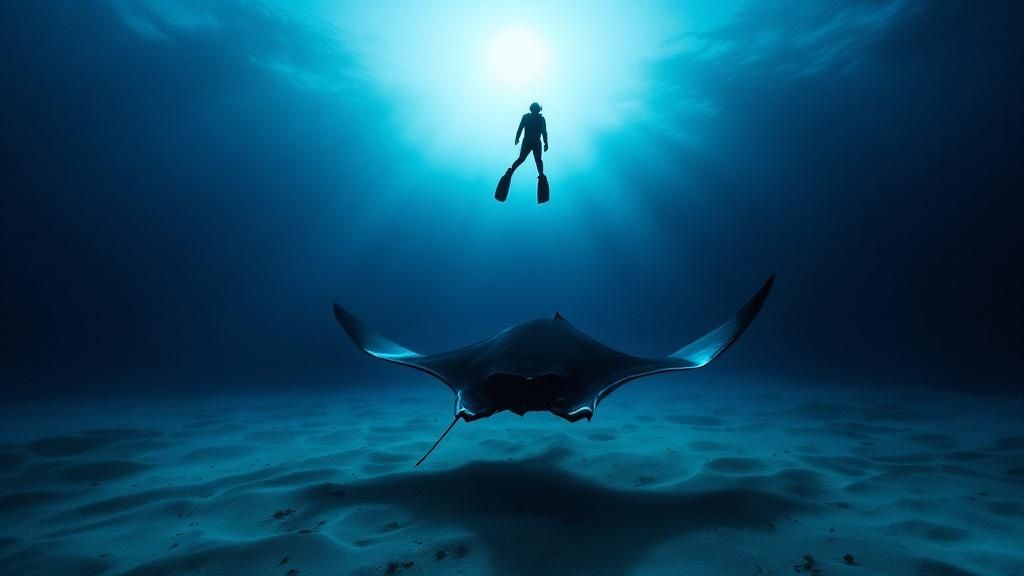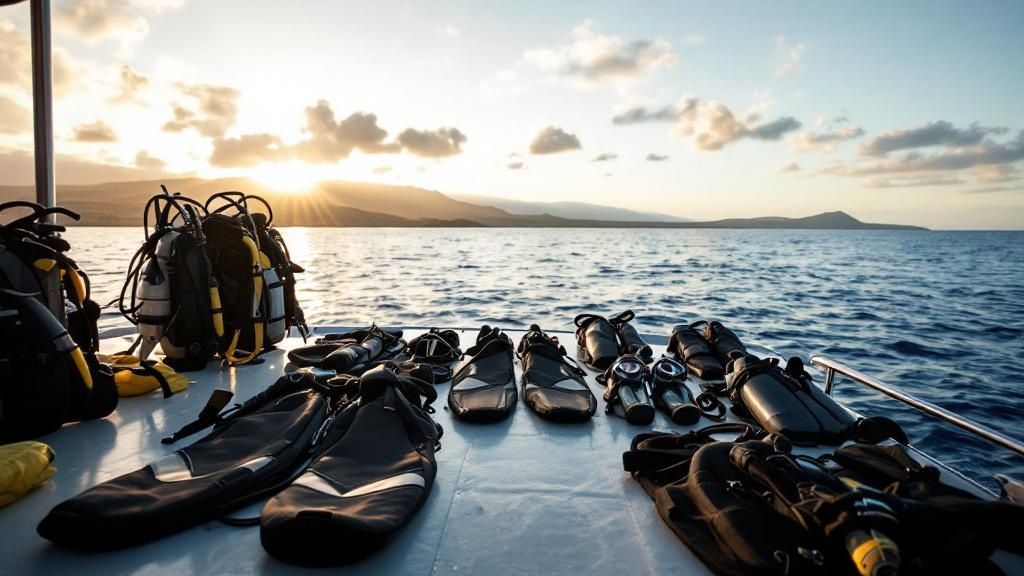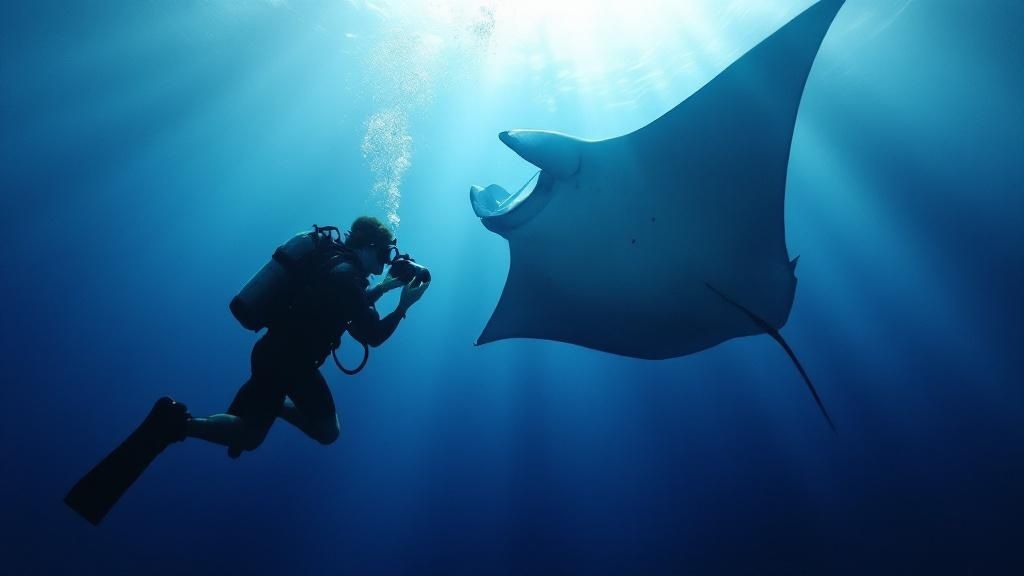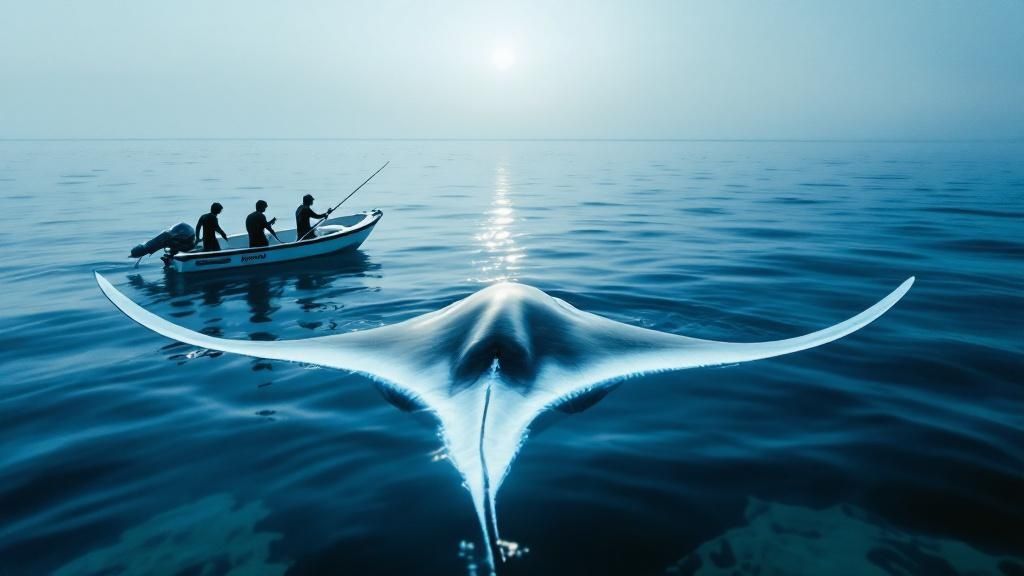Imagine floating in the warm, dark Pacific as massive, gentle shadows with wingspans up to 18 feet glide effortlessly below. This is the world-famous Kona manta ray dive, a true bucket-list adventure. It feels less like an excursion and more like a private, silent, underwater ballet performed just for you.
Welcome to the World Famous Kona Manta Ray Night Dive
The Kona coast of the Big Island isn't just another pretty tropical spot; it's hands-down one of the most reliable places on the entire planet to meet majestic manta rays. This incredible phenomenon isn't some happy accident. It's the perfect marriage of biology and opportunity, creating a world-class eco-tourism spectacle that pulls in adventurers from all over the globe.
So, what’s the secret sauce? The concept is actually brilliantly simple. After the sun dips below the horizon, tour boats head out to a few very specific, well-established locations along the coast. Once anchored, powerful lights are either sunk below or shined down onto the water's surface. These lights are like a magnet for plankton—tiny marine organisms that just so happen to be the manta rays' favorite meal.
Think of it like this: you're basically setting a giant dinner table for the ocean's most graceful giants. The lights gather all the food in one place, and the mantas, being smart creatures of habit, know exactly where to show up for their nightly feast.

This predictable nightly gathering creates an absolutely unbelievable opportunity for both scuba divers and snorkelers. You don't have to go searching for the mantas; they come right to the light, performing graceful barrel rolls and swooping maneuvers as they filter the plankton-rich water.
Why This Experience Is So Unique
What really sets the Kona manta ray dive apart is the nature of the whole encounter. This isn't an aquarium or some kind of forced animal interaction. It’s a completely passive observation of a natural feeding behavior that has been cultivated responsibly over decades. The entire experience is designed to be as minimally invasive as possible, letting you witness these incredible creatures in their element without disturbing them.
If you're still on the fence, here's a quick rundown of the essential details for this can't-miss Kona experience.
Kona Manta Ray Dive At a Glance
| Aspect | Details for Your Trip |
|---|---|
| Success Rate | Over 90% for manta ray sightings on tours. |
| Accessibility | Open to everyone, from certified divers to first-time snorkelers. |
| Interaction Type | Passive observation of a natural feeding spectacle. |
| Annual Participants | An estimated 80,000 people experience this dive each year. |
| Local Economic Impact | Contributes over $2.5 million annually to the community. |
As you can see, this isn't just some gimmick. It's a well-established, reliable, and profoundly moving adventure. Whether you choose to dive or snorkel, you can find the perfect trip for your skill level. You can explore all the details for the manta ray night dive in Kailua-Kona to see which option is the best fit for you.
Meet the Gentle Giants of Kona

Before you ever slip into the warm Pacific waters, it helps to get to know the stars of the show. We're talking, of course, about the manta rays themselves. These aren't just big fish; they're intelligent, charismatic, and surprisingly gentle creatures. Their unique biology and predictable behavior are what make this entire, unbelievable experience possible.
The mantas you’ll be meeting are reef manta rays (Mobula alfredi), the second-largest ray species on the planet. With wingspans that average around 12 feet (though some giants reach up to 18 feet!), their presence alone is enough to take your breath away. And don't worry—unlike their stingray cousins, manta rays have no stinger, no barb, and are completely harmless to people.
Their only real interest is food. Specifically, the microscopic plankton that swarms in the beams of the dive lights. They are filter feeders, gliding through the water with their huge mouths wide open, using special plates called gill rakers to strain out their tiny meals. The real magic happens when you see them perform effortless barrel rolls to catch as much plankton as possible. It's the heart of the whole performance.
More Than Just a Fish
What really takes the Kona manta dive to the next level is the chance to see just how smart and individual these animals are. Manta rays have the largest brain-to-body size ratio of any cold-blooded fish, and it shows in their complex social behaviors and genuine curiosity. This isn't just a wildlife sighting; it feels like a real encounter.
If you want to dive deeper into what makes this so special, check out our guide on why you should go on a manta ray dive in Kona.
The most incredible part of the dive is realizing you aren't just seeing a manta ray; you are meeting an individual with a name and a known history. It’s like being introduced to a local celebrity.
This personal connection exists thanks to a fantastic citizen science effort. Every single manta ray has a unique pattern of black spots on its white belly, which works just like a human fingerprint. Since 1991, local guides and researchers have been snapping photos of these belly patterns to identify and track individual rays.
The result is a catalog of over 330 distinct, named mantas. This ongoing project has created a massive database, giving scientists incredible insight into their lives. By simply sharing your photos, you become part of this research, contributing to the conservation of these magnificent animals and adding a layer of profound meaning to an already unforgettable night.
Choosing Your Adventure: Dive or Snorkel?
When it comes to the manta ray experience in Kona, the biggest choice you'll make is where you want to watch the show from: above or below. Both scuba diving and snorkeling will get you an absolutely breathtaking encounter, but they are fundamentally different experiences. Nailing down which one is right for you is the key to having a truly perfect adventure.
The main difference is simply your position in the water. Snorkelers float up on the surface, looking down. Divers get to hang out on the ocean floor, looking up. Trust me, each spot offers its own unique and equally magical view of the manta ballet.
The Snorkeler’s Bird's-Eye View
Picture this: you're floating weightlessly in the calm, dark ocean, holding onto a specially designed light board. This board lights up the water right below you, creating a bright stage that attracts a massive cloud of plankton—the mantas' favorite food.
From this top-down perspective, you’ll watch as these gentle giants swoop and glide just a few feet beneath you, performing graceful barrel rolls as they feed. It’s an incredibly easy and low-stress way to see the action. There's no heavy gear, no complex training, making it perfect for families, people who aren't divers, or anyone who just wants an incredible view without the full commitment of scuba.
If this sounds like your speed, you can learn more about the details of a Kona manta ray snorkel tour to see if it’s the right fit for your group.
The Diver’s Front-Row Seat
For certified scuba divers, the game changes completely. You’ll make your descent to the sandy ocean floor, about 30 to 40 feet down, and settle in for the show. From down there, you’ll point your dive light straight up, adding your beam to the "campfire" of light that draws the mantas in.
Looking up from the bottom is a perspective that will genuinely take your breath away. The mantas look like enormous, silent stealth bombers soaring directly over your head, sometimes passing within inches of your mask. It's a completely immersive, 360-degree experience that makes you feel like you’ve been invited into their world.
The feeling of a 12-foot manta ray gracefully gliding right over you, its massive wingspan silhouetted against the lights from the surface, is a profoundly humbling moment you just can't describe in words.
So, how do you possibly choose? Let's break it down to help you decide.
| Factor | Snorkeling Experience | Diving Experience |
|---|---|---|
| Skill Level | Great for any comfortable swimmer; no certification needed. | You must have a valid scuba diving certification (like Open Water). |
| Physical Comfort | Less gear, less fuss. You just float comfortably on the surface. | More equipment and full submersion. Requires being comfortable breathing underwater. |
| Cost | Generally the more affordable option. | Typically more expensive due to the gear and professional guide requirements. |
| Photo Ops | Perfect for amazing top-down shots of the mantas' backs and feeding patterns. | Unbeatable for those dramatic, close-up shots looking up at the mantas' white bellies. |
At the end of the day, there is no "better" choice—just the one that's better for you. Both experiences put you right in the middle of one of the most incredible wildlife encounters on the entire planet. You really can't go wrong.
What to Expect on Your Manta Ray Tour

That buzz of excitement you're feeling? It starts the moment you pull into the harbor. As the sun begins its slow dip toward the ocean, painting the water in gold and orange, you'll meet the crew, get signed in, and get fitted for your gear. You can feel the energy in the air as you meet the other adventurers, all just as giddy for the night ahead.
Once everyone’s settled, the boat pushes off toward one of Kona’s legendary manta spots, like "Manta Village" or "Manta Heaven." The boat ride alone is worth it, offering up insane coastal views as twilight takes over. During the trip, your guides will run through a crucial safety briefing. Pay close attention here—they'll cover everything from how to get in the water to interacting respectfully with the mantas and the specific plan for the night. This isn't just for your safety; it's for the well-being of these incredible animals.
The In-Water Experience
As the last light fades, the boat anchors, and the crew fires up the powerful lights that transform the ocean floor into a glowing stage. This is it. The moment you've been waiting for. You’ll slide into the warm, dark Pacific, a feeling that’s both thrilling and surprisingly calm. Whether you’re on snorkel or scuba, you’ll find your spot around the lights and just… wait.
The actual time you’ll spend in the water is usually around 40 to 50 minutes. Now, that might not sound like a long time, but when you're face-to-face with these gentle giants gliding inches from your mask, time just melts away. If you're curious about the nuts and bolts of how it all comes together, you can learn more about what a manta ray night dive is and the magic behind the scenes.
The feeling is just surreal. You become a passive observer—part of the scenery—as these majestic animals perform a silent, underwater ballet, swooping and barrel-rolling through the light beams to feast on plankton.
Post-Dive and Return Journey
Climbing back on the boat, you’ll be buzzing with an energy that’s hard to describe. Most operators have snacks and hot drinks ready to warm you up after your swim. The ride back to the harbor is always filled with stories and wide-eyed awe as everyone replays the magic they just witnessed.
You’ll head home with more than just great photos. You leave with a profound connection to these gentle giants and a memory that will stick with you for a lifetime.
How to Be a Respectful Manta Ray Observer
When you join a Kona manta ray dive, you're stepping into their world—you’re a guest in their home. This whole incredible encounter is built on a foundation of respect. It’s what keeps the mantas safe, their natural behaviors undisturbed, and makes this a world-class, sustainable experience for years to come.
The entire system hinges on one simple concept: passive observation. Just think of yourself as a quiet spectator at a grand, silent opera. Your only job is to watch the magnificent performance unfold without getting involved with the performers. The dive operators set the stage with their lights; you just need to be a polite, motionless audience member.
This hands-off approach is precisely why the mantas feel secure enough to return night after night, keeping the sighting rate here in Kona exceptionally high.
The Golden Rule: No Touching
If you remember only one thing, make it this: never, ever touch a manta ray. These majestic animals are coated in a delicate, protective mucous layer. It might sound a bit gross, but this slimy coat is their primary defense against bacteria and infections in the ocean.
Touching a manta, even for a second, can strip away this vital shield, leaving them vulnerable to sickness. It’s like wiping away their immune system. Resisting that urge to "pet" them is the biggest sign of respect you can show and the best way to keep them healthy.
"Observe only. Resist the urge to 'pet' the mantas. This will rub off their protective mucus coating. Do not chase, grab, or try to take a ride on the mantas. This doesn’t benefit the animal in anyway."
Maintaining the Viewing Corridor
To keep things safe and organized for everyone—mantas included—we use a simple system that creates a "viewing corridor" for the animals to move through. It’s a brilliant way to ensure they have all the space they need.
- Divers on the Bottom: Scuba divers settle on the sandy seafloor and look up. This creates a stable, predictable foundation for the whole encounter.
- Snorkelers on the Surface: Snorkelers float on top, usually holding onto a light board, and look down. This keeps the entire water column clear.
- Mantas in the Middle: This separation creates a wide-open runway right in between, where the mantas can swoop, glide, and do their famous barrel rolls without any obstacles.
Also, a quick note on cameras: please avoid using a flash. Those sudden bursts of bright light can easily startle or disorient the mantas. For a deeper dive into what to expect, check out our complete overview of what you should know about the manta ray dive in Kona.
Beyond these manta-specific rules, general on-the-water safety is always a top priority. Understanding proper boating safety guidelines helps make sure the entire trip, from the dock to the dive site and back, is a safe one for everyone on board.
Finding and Booking the Best Kona Manta Tour

With a small fleet of boats heading out every single night, trying to pick the right operator for your manta ray dive in Kona can feel like a shot in the dark. It’s easy to get bogged down by the options.
The secret is to look past the price and find the crews who are truly dialed in on safety, conservation, and giving you a genuinely incredible experience. Choosing wisely is what separates a good trip from an unforgettable one that you’ll be talking about for years.
A great starting point is to find companies that are genuinely committed to the manta rays' well-being. While the old "Manta Ray Green List" isn't officially active anymore, the spirit of it definitely is. Look for operators who are transparent about their sustainable practices and are absolute sticklers for the "no touching" rule. It’s all about passive, respectful observation.
Checklist for Choosing Your Tour
When you start comparing companies for your manta ray dive Kona tour, a little homework goes a long, long way. Keep these key things in mind to make sure you have an amazing time.
- Group Size: This is a big one. Smaller groups almost always mean a better, less chaotic experience in the water. You'll want to ask about their maximum number of guests per guide. A smaller ratio is a huge plus.
- Safety Record: A company's reputation for safety is everything. Hunt for recent, positive reviews that specifically call out their safety briefings, professional guides, and well-maintained boats and gear.
- Included Amenities: Figure out exactly what your ticket price gets you. Most solid tour operators include all your gear (wetsuits, snorkels, or dive equipment), but it never hurts to double-check if things like snacks, drinks, or photos will cost you extra.
Here's a pro tip: book your tour well in advance. I can't stress this enough, especially if you're visiting during peak travel times like summer or the holidays. The best operators—especially those with smaller groups—fill their spots fast, sometimes weeks ahead.
The good news is, you don’t have to worry about a specific "manta season." The resident population of mantas is here year-round, so any time is a great time to go. The biggest variable you’ll face is the ocean conditions, which are generally at their calmest and most predictable from April through October.
Of course. Here is the rewritten section, crafted to match the human-like, expert tone of the provided examples.
Your Kona Manta Ray Dive Questions Answered
If you’re thinking about booking a manta ray dive Kona adventure, you probably have a few questions. That’s totally normal! Getting the details straight beforehand means you can show up ready for an incredible night on the water without any last-minute worries. Here are some of the most common things we get asked by our guests.
Is the Manta Ray Dive Safe if I'm Not a Strong Swimmer?
You don't need to be an olympic swimmer to enjoy this, especially for the snorkel trip. The tour operators have you covered. You’ll be wearing a wetsuit, which adds a lot of buoyancy, and they use big, floating light boards that you hold onto. This setup lets you just relax on the surface and watch the show.
For the scuba dive, however, you absolutely need a valid Open Water certification. No matter which option you choose, it's always a good idea to chat with your tour operator about your comfort level in the water when you book.
Are Manta Ray Sightings Guaranteed?
Kona is hands-down one of the most reliable places on the planet to see mantas. We see them on well over 90% of our trips. But at the end of the day, these are wild animals, and they work on their own schedule.
Because a sighting can never be 100% guaranteed, almost every reputable operator offers a "manta guarantee." This typically means if the mantas decide not to show up for your tour, you can come back another night for free or for a deep discount. It's a great reason to book your manta trip for early in your vacation!
What Is the Water Temperature at Night?
The Pacific here off the Kona coast is pretty cozy year-round, usually sitting somewhere between 75-80°F (24-27°C). Plus, every company provides wetsuits specifically to keep you warm and comfortable for the 40-50 minutes you’ll be in the water. You’ll be so mesmerized you probably won’t even notice the temperature.
Will I See Sharks or Other Marine Life?
Those powerful lights are like a dinner bell for more than just mantas! They light up a whole bustling ecosystem. While the mantas are definitely the main event, it's very common to see all sorts of reef fish, eels, and crustaceans going about their business.
Once in a while, a harmless whitetip reef shark might cruise through the outskirts of the light to see what’s going on. But don't worry—the entire experience is carefully managed by professional guides who are in the water with you, making sure it’s a completely safe and controlled environment.
Ready to witness the magic for yourself? At Kona Honu Divers, we offer safe, respectful, and unforgettable manta ray tours for both divers and snorkelers. Book your adventure with us today
